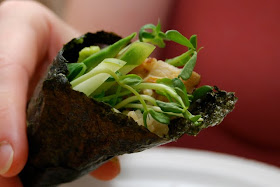It's been kinda hot here in Yankee Land. Mock me if you must, but here's the thing: Where I come from all houses are climate-controlled, and my attic here offers no respite. In Texas, I didn't mind exercising in 100F+ weather*, but I kept the AC in my house at a comfortable 76F from late-April through early October. Now when it's 85F outside, it's over 90F in my afternoon sun-drenched kitchen. This can make cooking anything unpleasant when even my little toaster oven puts out an unbearable amount of heat.
Salads and hummus plates are my friends, but I like the act of cooking enough that I also see the heat as a challenge, which lead me to an amazing discovery: You can cook pasta in the microwave! A pound of pasta cooks in 13 minutes, which isn't really faster than cooking it on your stove [~5 minutes for your water to boil+ 7-10 minutes cooking time] but it
doesn't add any heat to the kitchen, and this I will take as an unqualified victory.
After it's cooked, I dumped it on top of some homemade frozen pesto cubes and sliced cherry tomatoes, let it sit until the heat from the pasta thawed the sauce, tossed in some fresh basil from the garden, and topped it with cracked black pepper and an extra drizzle of good olive oil. It's easy and it can be served at any temperature.
Recipe: Microwave Pasta
*No, not "dry heat." Austin's relative humidity is usually between 70-90 percent, and the "heat index" is often 10-15 degrees hotter than the actual temp. [Where I grew up further west, it
was a dry heat, but the true temp was also 10-20 degrees hotter than Austin on any given summer day.] Boston's prevailing weather goes out to sea instead of drawing it in, and the humidity is less than 50 percent most of the time. I still don't understand why people who find out where I'm from want me to agree that New England August is more oppressive. I used to live in Houston** with window units, which in August is kind of like living inside someone's mouth... there's simply no contest. Just stick to your winters, people, you win every time.
**Houston is a great city with an amazing art scene and worldclass research institutes. Anyone who thinks it's a hole probably never got past the vast suburbs... but it
was built on a swamp and I don't miss those summers.



























